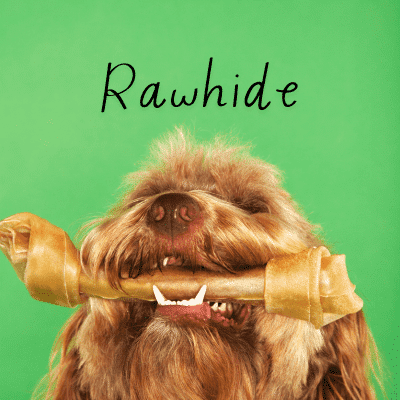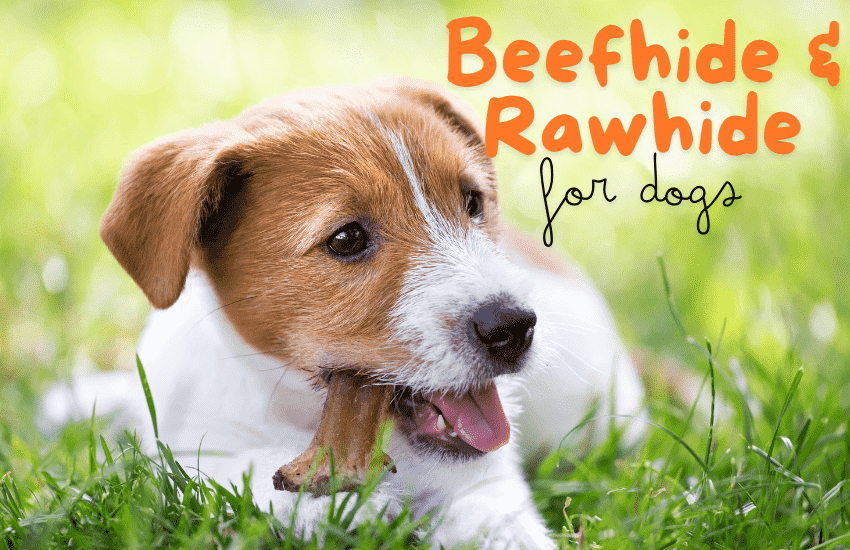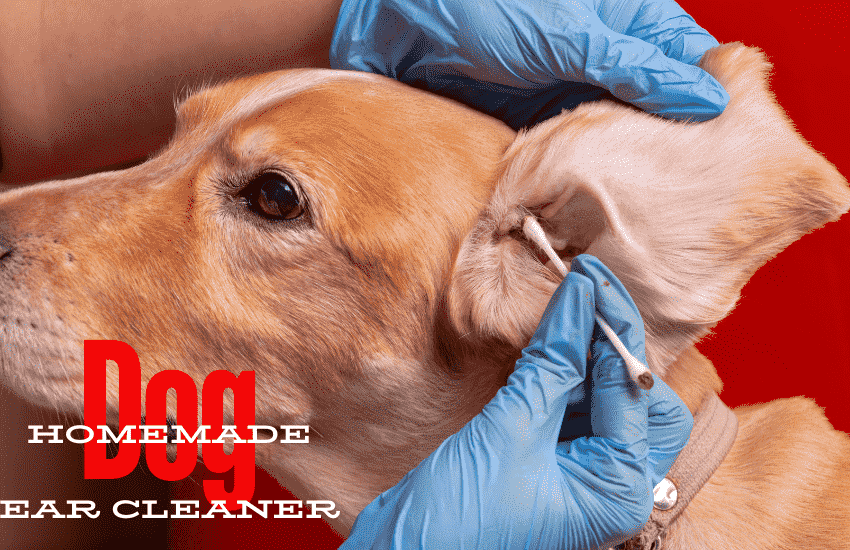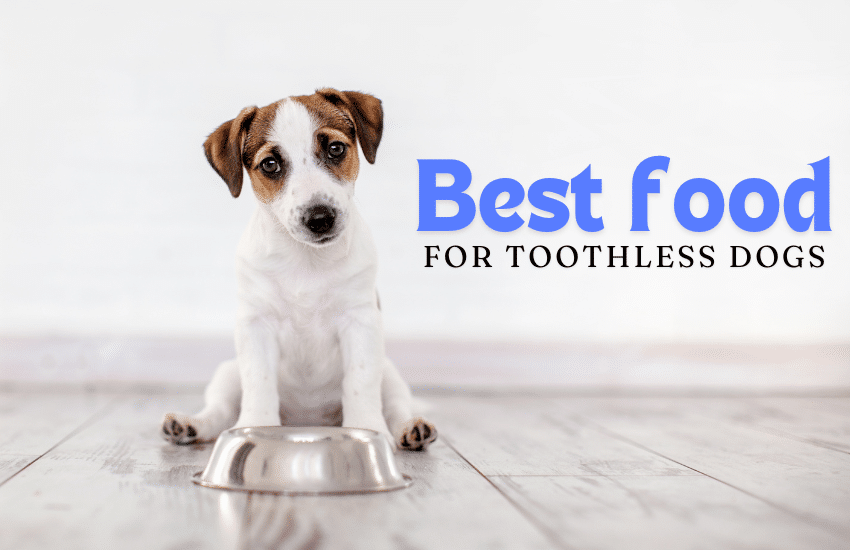Beefhide is essentially the same as rawhide, both made from the inner layer of cowhides. Beefhide and rawhide chews offer dogs extended entertainment and dental benefits.
Dog owners frequently seek out beefhide and rawhide to satisfy their pets’ natural urge to chew. These chews are not only a source of amusement but also aid in maintaining healthy teeth by reducing plaque and tartar build-up. It’s important to select high-quality chews and supervise your dog while they enjoy these treats to ensure their safety.
With a variety of shapes, sizes, and flavors available, beefhide and rawhide chews can cater to any dog’s preference, making them a popular choice among pet owners looking for a reliable solution to their dogs’ chewing needs. Always prioritize your dog’s health by choosing appropriate chew sizes and monitoring for any signs of digestive distress or choking hazards.
What Is Beefhide?
Is Beefhide the Same As Rawhide for Dogs and What is Beefhide? Pet owners often ponder this question while selecting the best chew options for their canine friends. Beefhide is a specific type of rawhide made exclusively from cow skin. Unlike generic rawhide, which can come from various animals, beefhide offers a more consistent and often higher quality chew for dogs. It’s an excellent tool for dental health, keeping dogs busy, and preventing them from chewing on unwanted items. Let’s delve into the specifics of beefhide and understand what sets it apart.
Composition Of Beefhide
Understanding the composition of beefhide is crucial for dog owners who care about their pet’s health and well-being. Here’s a breakdown of what beefhide consists of:
- Natural Protein: Beefhide is rich in protein, which is vital for a dog’s muscle development and energy levels.
- Fibers: The tough texture helps in cleaning teeth and massaging gums as dogs chew on it.
- Water: A small percentage of beefhide is water, which gets reduced during the production process.
- Fats: It contains minimal fats, making it a lean chew option for dogs.
The beefhide also includes trace minerals that contribute to a dog’s overall nutrition. The following table highlights the key components found in beefhide:
| Component | Description |
|---|---|
| Protein | Essential for body functions and energy |
| Fibers | Assist in dental health |
| Water | Present in raw form, reduced during drying |
| Fats | Low content, ensuring a lean chew |
Production Of Beefhide
The production of beefhide involves several steps to ensure safety and quality. It begins with sourcing the hides from cows, which are then cleaned and cut into various sizes suitable for dogs. Below is an outline of the process:
- Cleaning: Hides are thoroughly cleaned to remove any bacteria and contaminants.
- Soaking: To make the hides pliable, they are soaked in water.
- Splitting: The hides are then split into layers; the top layer is used for beefhide chews.
- Shaping: After splitting, the hides are cut and formed into shapes and sizes for dog chews.
- Drying: The cut pieces are dried to reduce moisture and harden the texture.
- Packaging: Finally, the beefhide chews are packaged and ready for distribution.
This meticulous process ensures that every piece of beefhide is safe for dogs to enjoy. The emphasis is on maintaining a natural chew without adding harmful chemicals or artificial preservatives. Here’s a simplified flowchart to visualize the production stages:
- Clean raw hides
- Soak and prepare for splitting
- Split into layers for chews
- Shape and size for dogs
- Dry to achieve the right texture
- Package for sale
Through this careful production, beefhide remains a popular and trusted choice for dog owners seeking a natural, long-lasting chew for their pets.
What Is Rawhide?
Many pet parents wonder if beefhide and rawhide are the same for their furry friends. Rawhide is a popular dog chew made from the inner layer of cow or horse hides. By understanding what rawhide is, owners can make informed choices about their dog’s treats. Let’s dive into the details of rawhide, including its composition and production.
Composition Of Rawhide
Rawhide chews come from the dense, inner layer of animal hides, specifically cows or horses. This layer is separated and cleaned to create the rawhide used in these chews. Here’s what you need to know about its composition:
- Primarily made of collagen, a protein that is tough and fibrous.
- Low in fat and high in protein, making it a lean chew option for dogs.
- Contains trace amounts of minerals that can benefit a dog’s health.
- Rawhide has a long-lasting texture that dogs love to chew.
The table below shows the typical composition of rawhide:
| Component | Percentage |
|---|---|
| Protein (Collagen) | 80-85% |
| Moisture | 10-14% |
| Fat | 1-2% |
| Ash (Minerals) | 1-2% |

Production Of Rawhide
The production of rawhide involves several steps to ensure the chew is safe for dogs. Here’s an overview of the process:
- Cleaning: The hide is cleaned to remove dirt, hair, and fat.
- Splitting: The hide is split into layers, and the top grain is separated.
- Soaking: The inner layer is soaked to soften and prepare for shaping.
- Cutting and Shaping: The rawhide is cut and shaped into chews.
- Drying: The chews are dried to remove moisture and harden.
During production, the rawhide may be treated with additives for flavor or preservation. Quality control is crucial to remove harmful chemicals and ensure safety. The steps below summarize the production cycle:
| Step | Description |
|---|---|
| 1. Cleaning | Remove impurities from the hide |
| 2. Splitting | Isolate the inner layer |
| 3. Soaking | Soften the hide for processing |
| 4. Cutting/Shaping | Create the final chew shape |
| 5. Drying | Ensure the chew is hard and dry |
Differences Between Beefhide And Rawhide
Many dog owners wonder, is beefhide the same as rawhide for dogs? While both may seem similar, they have distinct differences worth noting. Beefhide vs rawhide is not just about the name; it’s about the source, processing, texture, and safety for our canine friends. Understanding these differences can help owners make informed decisions on whether beef hide for dogs is a better choice than rawhide, or vice versa. Let’s dive into the details and clear up common questions such as is beef hide bad for dogs, or is beefhide good for dogs.
Source Of Material
When comparing beef hide vs rawhide, the source of the material is the first notable difference. Here’s what sets them apart:
- Beefhide is specifically made from the inner layer of cowhide, often implying a single-animal source.
- Rawhide, on the other hand, can come from various animals and may include other layers of hide, not just the inner layer.
This distinction is crucial because it affects the final product’s consistency and quality. For instance, is beefhide safe for dogs might have a different answer than if you were to ask the same about rawhide. The table below summarizes the source of each:
| Product | Source |
|---|---|
| Beefhide | Inner layer of cowhide |
| Rawhide | Various layers from different animals |
Processing Methods
The processing methods for beefhide and rawhide are another critical difference. These processes affect not only the product’s safety but also its digestibility:
- Beefhide often undergoes a more controlled and stringent cleaning process to ensure it’s safe for canine consumption.
- Rawhide, with its varied sources, might be treated with more chemicals to prevent spoilage and improve shelf life.
Some owners ask, is beef hide digestible? The answer lies in the processing. A cleaner and less chemical-heavy process typically leads to better digestibility for dogs. Knowing the processing method can help determine if beefhide for puppies is a suitable option.
Texture And Appearance
The texture and appearance of beefhide versus rawhide are not only visually different but can also affect a dog’s interest and chewing experience:
- Beefhide tends to be thicker and more uniform in texture, often resulting in a longer-lasting chew.
- Rawhide might be thinner and more variable, which could lead to quicker breakdown and potential choking hazards, like when a dog swallowed rawhide.
Owners concerned about is beefhide bad for dogs or is pork hide bad for dogs should consider these texture differences, as they can influence a dog’s ability to chew safely and enjoyably.
Safety Concerns
Safety is paramount when choosing between beefhide for dogs and rawhide. Here are some considerations:
- Is beefhide okay for dogs? Generally, yes, if it’s from a reputable source and processed correctly.
- Is rawhide the same as beefhide in terms of safety? Not necessarily. Rawhide has been linked to more choking incidents and digestive blockages.
It’s important to observe your pet’s behavior with these chews. Are beef hides good for dogs that are aggressive chewers? Perhaps, but always supervise to prevent any issues. Opting for alternatives like bully sticks vs rawhide might be safer for some pets.
Benefits Of Beefhide For Dogs
Dog owners often wonder if beefhide is the same as rawhide. The two may seem similar, but there are key differences. Most notably, beefhide is often more digestible, making it a safer choice for your furry friend. Let’s dive into the benefits of beefhide for dogs and see why it might be a better treat for your pet.
Chewing And Dental Health
Dogs have a natural urge to chew, and beefhide treats can satisfy this instinct while promoting dental health. Chewing on beefhide helps to:
- Remove plaque and tartar: As your dog chews, the beefhide rubs against their teeth, scraping away harmful buildup.
- Strengthen teeth and gums: The effort needed to chew beefhide can help strengthen your dog’s teeth and gum health.
- Freshen breath: Consistent chewing keeps saliva flowing, which helps to keep your dog’s breath fresher.
Is beef hide digestible? Compared to rawhide, beefhide is typically more digestible. This means that it is less likely to cause blockages in your dog’s digestive system if swallowed. Here’s a quick look at the benefits:
| Benefit | Description |
|---|---|
| Digestibility | Beefhide breaks down more easily in a dog’s digestive system. |
| Dental Care | Removes plaque and tartar, freshens breath. |
| Gum Health | Promotes stronger gums through vigorous chewing. |
Entertainment And Mental Stimulation
Beyond the physical benefits, beefhide chews offer mental stimulation for dogs. Chewing is a calming activity that can help reduce stress and boredom. Here’s how beefhide chews keep dogs entertained:
- Engages their mind: Figuring out how to chew and eat beefhide is a fun challenge for dogs.
- Provides long-lasting entertainment: Unlike other treats, beefhide takes time to chew, offering extended enjoyment.
- Reduces destructive behavior: Chewing beefhide can prevent dogs from chewing on household items.
For pet parents, it’s clear that beefhide chews are more than just a way to pass the time. They are tools that keep your dog’s mind active and engaged. As dogs work on their beefhide, they focus their energy on a safe and satisfying activity, which can be especially helpful for dogs with excess energy or anxiety.
Drawbacks Of Beefhide For Dogs
Many pet owners wonder if beefhide is the same as rawhide for their furry friends. Both come from the inner layer of cow hides. But the processing may differ, affecting the final product. Dogs love to chew, and these chews are popular. Yet, beefhide has drawbacks that dog owners should consider. Let’s explore the potential issues that could affect your dog’s health and safety.
Digestive Issues
Beefhide chews can lead to digestive problems for dogs. Here’s what you need to know:
- Hard to Digest: Beefhide is tough. It can be hard for dogs to break down in their stomach.
- Blockages: Large pieces swallowed might block their intestines.
- Upset Stomach: Some dogs may get sick or have diarrhea.
Consider the table below to see common issues and tips:
| Issue | Tip |
|---|---|
| Hard pieces | Choose softer chews |
| Swallowed whole | Supervise chewing time |
| Stomach upset | Try different treats |
Be careful with beefhide. It might not suit all dogs, especially those with sensitive stomachs or a habit of swallowing without chewing properly.
Choking Hazards
Choking is a serious risk with beefhide chews. Small pieces can get stuck in a dog’s throat. Here are key points to remember:
- Size Matters: Smaller dogs might choke on big pieces.
- Watch Them: Always keep an eye on your dog with their chew.
- Know the Heimlich: Learn how to help if your dog chokes.
Below is a quick guide on what to do if choking occurs:
- Stay calm and approach your dog carefully.
- Open their mouth to see if you can remove the blockage.
- If you can’t see it, don’t push your fingers deep into their throat.
- Use the Heimlich maneuver for dogs or seek immediate vet help.
Prevention is key. Always choose the right size of chew for your dog and keep close while they enjoy it.
Benefits Of Rawhide For Dogs
Many dog owners wonder if beefhide and rawhide are the same for their furry friends. While both come from animal hides, rawhide is more widely used as a chew for dogs. Rawhide benefits dogs in several ways, and it’s essential to know how it can help your pet. Let’s explore the positives of giving your dog rawhide chews.
Chewing And Dental Health
Rawhide is a popular chew choice for dogs because it promotes dental health. Here’s how:
- It helps remove plaque and tartar from teeth.
- Chewing stimulates saliva which protects teeth from decay.
- It can freshen breath and reduce bad odors.
Dogs have a natural urge to chew. Rawhide satisfies this need and prevents them from chewing on unwanted items like shoes or furniture. Chewing on rawhide is a workout for their jaws, strengthening their teeth and gums. A table below shows the impact of rawhide on dental health:
| Effect | Benefit |
|---|---|
| Plaque Reduction | Healthier Gums |
| Tartar Control | Stronger Teeth |
| Stimulated Saliva | Protected Enamel |
Remember, while rawhide is beneficial, it should be given under supervision to ensure your dog is safe while enjoying their chew.
Long-lasting Entertainment
Rawhide isn’t just good for dental health; it’s also a source of long-lasting entertainment for dogs. Look at the benefits:
- Keeps dogs busy and engaged for hours.
- Helps reduce anxiety and boredom.
- Can prevent destructive behavior by providing an outlet for energy.
When dogs focus on chewing rawhide, it’s like giving them a fun task. They feel accomplished after working through a piece of rawhide. This activity is especially beneficial when dogs are alone, preventing loneliness and separation anxiety. The table below shows the entertainment value of rawhide:
| Duration | Effect |
|---|---|
| Short-Term | Immediate Fun |
| Long-Term | Continuous Engagement |
| Overall | Happy and Content Dog |
Offering rawhide chews is a smart way to keep your dog entertained. Always choose the right size and type for your dog’s breed and chewing habits to ensure they enjoy their treat safely.
Drawbacks Of Rawhide For Dogs
Is Beefhide the Same As Rawhide for Dogs and the Drawbacks of Rawhide for Dogs are topics of concern for pet owners. Beefhide is often confused with rawhide, but they are not exactly the same. Rawhide is made from the inner layer of cow or horse hides, whereas beefhide is specifically made from beef cattle skin. Despite their popularity, rawhide chews pose risks to dogs. It’s crucial to understand these drawbacks to keep your furry friend safe and healthy.
Digestive Issues
Many dogs enjoy gnawing on rawhide treats, but these chews can lead to serious digestive issues. Here’s why:
- Hard to Digest: Rawhide is tough and can be difficult for dogs to break down. This can cause intestinal blockages if large pieces are swallowed.
- Upset Stomach: Some dogs may experience stomach irritation or diarrhea after chewing rawhide. This is often due to the hide’s rough nature.
Consider the following table showing common digestive problems linked to rawhide:
| Issue | Description | Precaution |
|---|---|---|
| Blockages | Large pieces can obstruct the digestive tract. | Supervise chewing and choose appropriate sizes. |
| Irritation | Rawhide can irritate the stomach lining. | Offer in moderation and watch for reactions. |
| Diarrhea | Sudden dietary changes can cause loose stools. | Introduce rawhide slowly into your dog’s diet. |
Choking Hazards
Choking is a real danger when dogs chew on rawhide. Small pieces can get lodged in their throats, leading to a scary situation. Always watch your dog while they enjoy their chew to prevent accidents. Be aware of these risks:
- Size Matters: Smaller dogs may try to swallow pieces that are too big, causing them to choke.
- Swelling: Rawhide expands when wet and can block the airway if swallowed.
Here’s a quick list of tips to reduce choking risks:
- Choose the right size of rawhide for your dog’s breed and size.
- Do not leave your dog unattended with a rawhide chew.
- Remove small or swollen pieces immediately.
Chemical Treatments
Rawhide chews often undergo chemical treatments during manufacturing. These chemicals can be harmful to dogs. Here’s what pet owners need to know:
- Potential Toxins: Chemicals like bleach and formaldehyde may be used to clean and preserve rawhide.
- Artificial Additives: Flavors and colors added to rawhide can cause allergic reactions in sensitive dogs.
For safer alternatives, consider these options:
- Digestible dental chews
- Natural treats like bully sticks
- Untreated leather toys
Choosing the right chew for your dog requires understanding these drawbacks of rawhide. By doing so, you ensure your pet’s safety and well-being.

Credit: www.usedvetequipment.com
Frequently Asked Questions
What’s The Difference Between Beefhide And Rawhide?
Beefhide is made from the inner layer of cowhide, while rawhide generally refers to the entire hide, including both the top grain and inner layers. Beefhide is typically thicker and more durable due to its specific sourcing from beef cattle.
Are Beefhide Chews Safer Than Rawhide For Dogs?
Beefhide chews are often considered safer for dogs as they are usually more digestible. They are less likely to splinter and are processed without as many chemicals as rawhide, reducing the risk of gastrointestinal blockage or contamination.
How Do Beefhide And Rawhide Affect A Dog’s Digestion?
Beefhide is typically easier to digest for dogs compared to rawhide. Rawhide can swell in a dog’s stomach and is harder to break down, which could lead to digestive blockages or upset if consumed in large pieces.
Can Beefhide Chews Help With Dental Health?
Yes, beefhide chews can help maintain dental health by aiding in plaque removal and massaging gums. They are effective in keeping dogs’ teeth clean through the natural action of chewing, which can help prevent dental issues.
Conclusion
Understanding the differences between beefhide and rawhide is crucial for dog owners. Both options have their benefits, yet they aren’t identical. Choosing the right chew depends on your dog’s needs and health. Remember, always prioritize safety and consult with a vet to ensure the best choice for your furry friend.






